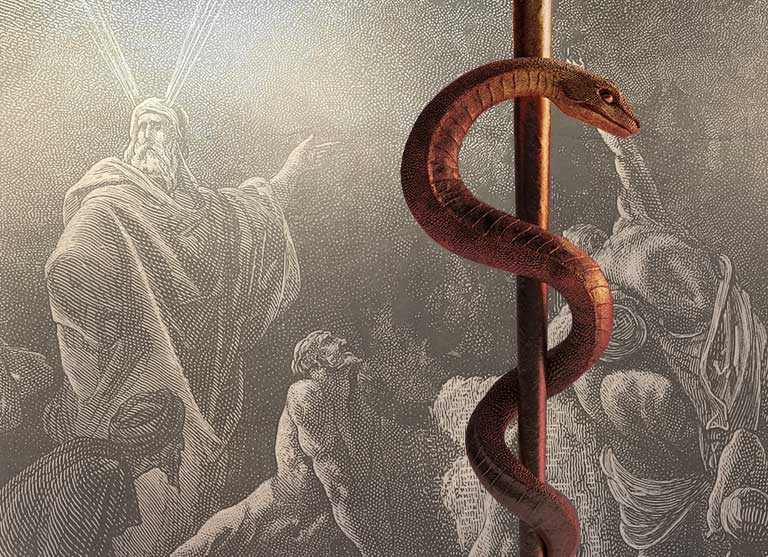This article is part of a series on Old Testament Christophanies. For important background information, see An Introduction to Old Testament Christophanies–with Justin Martyr.

In the same chapter where he wrote that “Christ” was the rock that followed the Israelites (1 Cor 10:4), the apostle Paul wrote that Christ had been with the people a second time:
We must not put Christ to the test, as some of them did and were destroyed by serpents, (1 Cor 10:9 [ESV]).[1]
Paul’s reference is to an incident recorded in Numbers 21:5–6. Impatient with their journey, the Israelites spoke against God and Moses. They asked why they had been brought out of Egypt to die in the wilderness, where there was nothing to eat or drink except for manna, which they had grown to hate. In response, Yahweh sent venomous serpents that bit the people, causing many of them to die. The Targums say that the Israelites spoke against “the Word of the Lord.”[2] Likewise, two Targums say that “the Word of the Lord” sent the serpents.[3] These ancient Jewish paraphrases agree with the apostle: it was the Word of the Lord who was tested. Paul understood that the Word of the Lord in the wilderness was the preincarnate Christ.
According to Exodus 23:21, it was the Angel with Yahweh’s name in Him, the Angel of the Lord, who would not pardon the people’s transgressions. Paul identified the member of the Godhead who sent the serpents as Christ. Therefore, the Angel of the Lord was Christ. In his commentary on Exodus 23:20–23, famed Bible expositor Matthew Henry (1661–1714) came to the same conclusion: “Christ is the Angel of Jehovah; this is plainly taught by St. Paul, 1Co 10:9.”[4]
Continuing through Numbers 21:7–9, we read that the people, recognizing that they had sinned, asked Moses to intercede. Moses did so and then he followed the Lord’s instructions by making a bronze serpent and setting it on a pole, so that anyone who was bit could look upon it and live. Although from the Lord, and therefore of divine purpose, the serpent upon the pole must have seemed like an unusual source of healing. However, Jesus revealed to Nicodemus that the serpent being lifted up in the wilderness pointed to the Son of Man being lifted up on the cross (John 3:14). (The serpent was likely set upon a cross atop the pole.) A serpent represents sin, and God made “Him who knew no sin to be sin on our behalf, so that we might become the righteousness of God in Him” (2 Cor 5:21). Christ punished the Israelites for their sin, but He also provided a way for them to be saved.
Paul’s use of Christ in 1 Corinthians 10:9 emphasizes the apostle’s overall argument in 1 Corinthians 10:6–11: the punishments that happened to the Israelites in their relationship with Christ are examples for us in the Body of Christ. If Paul could identify Christ in a passage where Yahweh spoke but did not appear, then how much more so may we say that it is Christ when Yahweh appears on the earth?
[1] While the majority of manuscripts for 1 Corinthians 10:9, including many from the Alexandrian and Western text-types, have “Christ” (Gr. Christon), a minority of manuscripts have “Lord” (Gr. kurion) or “God” (Gr. theon) instead. For essentially the same reason that the inclusion of “Jesus” in Jude 1:5 likely led to its variant readings, some scribes apparently had an issue with the anachronistic use of “Christ” in 1 Corinthians 10:9, leading to its variant readings.
[2] Targum Onkelos and Targum Pseudo-Jonathanon Numbers 21:5.
[3] Targum Pseudo-Jonathan and the Jerusalem Targum on Numbers 21:6.
[4] Henry, Concise Commentary, Exod 23:20–33.

Blessed by this. Thank you.
I think you’re interpreting this backwards.
It’s not that Paul sees the pre-incarnate Christ in Numbers 21, but is rather participating in an extant 2nd Temple tradition that introduced an intermediary agent (the Memra/Word) into the narrative of the Hebrew Bible and sees that as an opportunity to place Christ there.
In other words, it’s not strictly an ontological phenomenon, but a textual one.
The link at the top of the article will take you to the first entry in the series where I introduce the Memra usage. In short, it’s not that the inclusion of the Memra in the Targums being what allowed Christians to “find” Christ, rather it was the recognition that there was a Yahweh who came to earth and represented the Yahweh in Heaven. Thus, the same recognition among Christians would naturally lead to agreement on several of these instances of Yahweh’s Word appearing. Moreover, John almost certainly referred to the Memra teaching in John 1 (among other places), in his own–inspired–teaching.